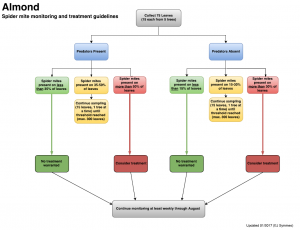Spider mite management in almonds can be accomplished through one of two general approaches: starting with a prophylactic early-season treatment or using threshold-based treatment timings and conservation biological control. Both have pros and cons, and each method can be used to successfully manage spider mites. This article will summarize each method.
Prophylactic approach: Early abamectin (Agri-mek®, generics) treatments have become the norm in many almond orchards in this region. When applied properly and at the appropriate time, abamectin can be a very effective miticide and these early treatments can control mites well into summer. Below are some key considerations regarding the most effective and responsible use of abamectin:
- Abamectin functions as a nerve toxin that must be ingested by mites. Once applied, the material must move into the leaf tissue, where it can then be picked up by feeding mites. This translaminar movement of the material works best prior to leaf hardening and when leaves are mostly free from dust and other residues. Applications before leaf hardening can be highly effective.
- Applying abamectin after leaf hardening (i.e., with hull-split sprays) may seem like an inexpensive insurance policy, even if the effectiveness of the material at this timing is greatly reduced. However, bear in mind two additional issues: this is the time when natural enemies tend to be more abundant if preserved early in the season (more on that below) and, from a resistance-management standpoint, two applications of the same active ingredient within the same season is not advisable.
- Abamectin is highly toxic to spider mite natural enemies, particularly sixspotted thrips and predator mites. Use of abamectin early in the season may contribute to later season spider mite flare-ups due to reduction or elimination of these beneficials in the orchard by direct toxicity and/or by reducing their food source (spider mites, European red mites, brown almond mites).
- Without beneficials to at least slow a mite flare up as the abamectin wears off (expect 60 days of activity if applied properly and at the tight time), spider mite populations can jump up to dangerous levels in just a couple of weeks in summer heat and water stress. Juggling irrigation/sprayer access, harvest prep activities, and crew availability to spray a sudden mite flare-up can mean the fix to a fast-moving problem isn’t fast enough, and that can mean dropped leaves at harvest. Lots of dropped leaves at harvest can mean slow drying nuts, slow nut pickup, longer water shut off and more orchard water stress that can translate to future yield loss.
- In years where spider mites are slow to develop (seems to be the case this year so far), “May sprays” of abamectin may be of very little value, as additional later-season sprays often become necessary regardless of early-season intervention, and natural enemies are unnecessarily disrupted. Weigh the pros and cons of the inexpensive insurance policy in treating below-threshold populations vs. destruction of natural enemies (FREE control) and consider how overuse of a particular chemistry over time can increase the likelihood of resistance development. Best to use practices that help maintain all of the tools in the toolbox so that they are available and effective when particular situations call for it.
- Here is a very good summary article on the uses (and misuses) of abamectin in almonds written by UCCE Entomology Advisor David Haviland.
Threshold and biological control approach: With this method, spider mites are treated once economic thresholds are reached (not before) and the overall goal is to maintain a balanced ratio of natural enemies-to-spider mites that will allow the beneficials to help suppress spider mite populations.
- Monitoring and treatment thresholds take into account the abundance of both the pest spider mites and their key natural enemies (predator mites and sixspotted thrips). For details, see the decision tree below and the UC IPM Spider Mite guidelines.

Click to Enlarge. Decision tree for spider mite monitoring and treatment. E.J. Symmes, 2017.
(Download a .pdf of the Almond Mite Control Decision Tree here)
- The basic tenet of conservation biological control (maintaining “good bugs” in our orchards to help control the pests) is “Don’t Starve Them & Don’t Kill Them.” Early season destruction of natural enemies and/or their food sources will likely mean that they will not be present, or not present in enough numbers at the right time, to provide measurable impacts later in the season when we need them to help fight flare-ups.
- Admittedly, predators alone may not be sufficient to keep spider mites below economically-damaging levels, and miticides may be needed based on your site-specific monitoring when thresholds are reached. Know which predators are present and choose materials accordingly. Using a miticide that is gentle on beneficials helps keep them around to suppress spider mites missed by the pesticide. This table details almond pesticides and their impact on beneficials, including predatory mites and sixspotted thrips.
- Best practices for getting the most out of your threshold-based miticide application include choosing the right material for the job (i.e., those softer on predators if they are present, desired residual activity and pre-harvest intervals, quick and effective knock-down if needed, etc.), obtaining optimal coverage (high volume, slow speed), and applying with oil or the recommended adjuvant.


Leave a Reply